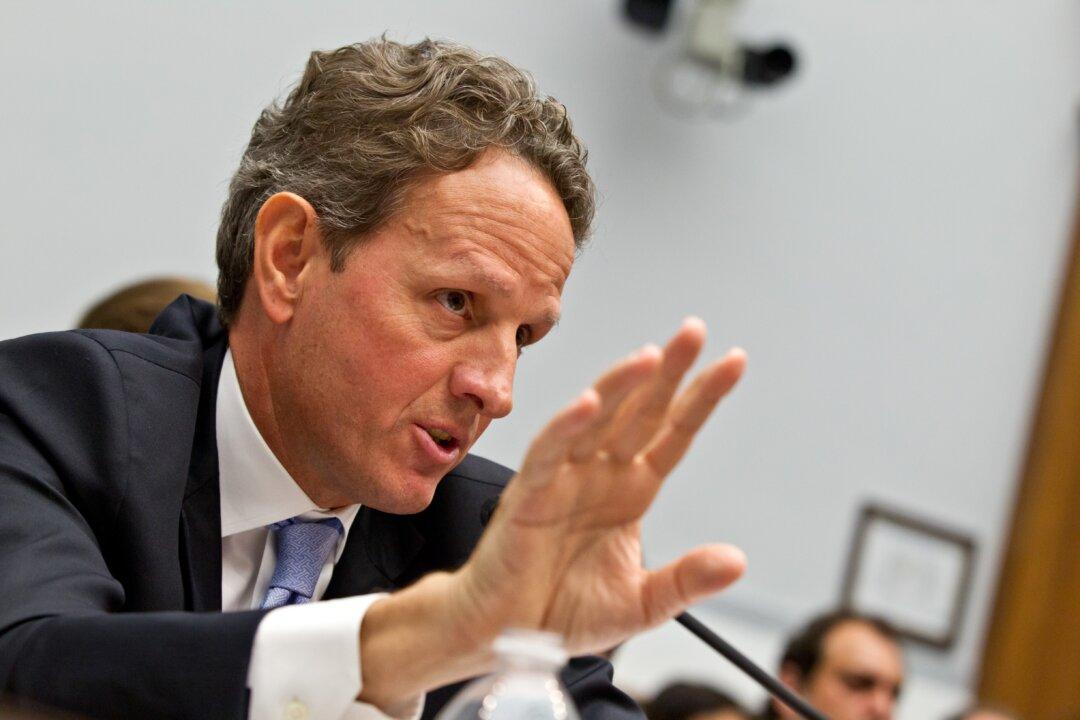WASHINGTON—Former top regulator Timothy Geithner defended terms of the U.S. government’s bailout of American International Group Inc., saying Wednesday that the insurance giant’s exceptionally risky behavior had caused losses that called for strict treatment.
The terms included a huge government stake in the company and an interest rate called “crazily high” by a government official.
Geithner headed the New York Federal Reserve when it extended an $85 billion rescue loan to AIG in September 2008 as the company veered toward collapse.
In trial testimony, Geithner said he and his colleagues at the Fed and the Treasury Department believed that AIG’s dire financial condition was “substantially” the result of its management taking on excessive risk.
AIG, which had operations around the globe, buckled after making huge bets on mortgage securities that soured.
The government stepped in with a total of nearly $185 billion in aid, which New York-based AIG has since repaid.
It was the second day of questioning for Geithner in the trial of a lawsuit brought by former AIG Chairman and CEO Maurice Greenberg. Greenberg is suing the federal government for about $40 billion in damages, asserting that it violated the Constitution’s Fifth Amendment by taking control of AIG without “just compensation” for the shares it received. The government took control of 80 percent of AIG’s stock in exchange for the bailout aid.
David Boies, the attorney representing Greenberg, tried to point out contradictions in Geithner’s statements about AIG’s risk-taking and build the case that AIG was given unfairly punitive treatment by the government compared with other big financial companies receiving aid.
As a general policy, Geithner testified, the government imposed losses on shareholders of bailed-out companies that were in proportion to the bad decisions made by their managers.
That would appear to explain the big equity stake the government took in AIG and the interest rate on the loan, which was set at about 12 percent annually. In testimony Tuesday, Geithner had noted the 3.5 percent rate on the government’s loan to Citigroup Inc., which received a $45 billion bailout. While affirming the necessity of the AIG bailout to avert catastrophe for the financial system, Geithner also acknowledged having said the bailout “wiped out” AIG shareholders.
In an Oct. 22, 2008 email cited by Boies, a New York Fed official called AIG’s interest rate “crazily high” and said it was “forced” on the New York Fed “by people that have since punted on all the hard things that came about as a result of the decision to lend” to AIG.
Geithner said the “people” likely referred to officials at the Federal Reserve Board in Washington or the Treasury Department.
In a deposition he gave earlier in the suit, Geithner said “AIG had taken much more risk” than other big financial institutions.
He testified Wednesday that he had “some direct knowledge” of the risks AIG had taken when New York Fed officials were monitoring the company’s condition in mid-September 2008.
But Boies pointed to another statement by Geithner from his deposition: “We had no basis for having any direct knowledge of the risks” because the Fed wasn’t the primary supervisor of AIG.
AIG became a symbol for excessive risk on Wall Street and a touchstone of public anger. It was criticized, among other things, for paying millions of dollars in bonuses to executives after it was bailed out.
Geithner left the New York Fed when he became Treasury Secretary in the Obama administration in January 2009.
On Monday Henry Paulson, a Treasury secretary under George W. Bush, testified at the nonjury trial that the AIG bailout was specifically designed by the government to punish the company. Paulson, who headed Treasury at the time of the rescue, said AIG shareholders should have faced punishment for the company’s troubled balance sheet.
Former Fed Chairman Ben Bernanke is scheduled to testify Thursday at the trial at the U.S. Court of Federal Claims in Washington.
From The Associated Press




